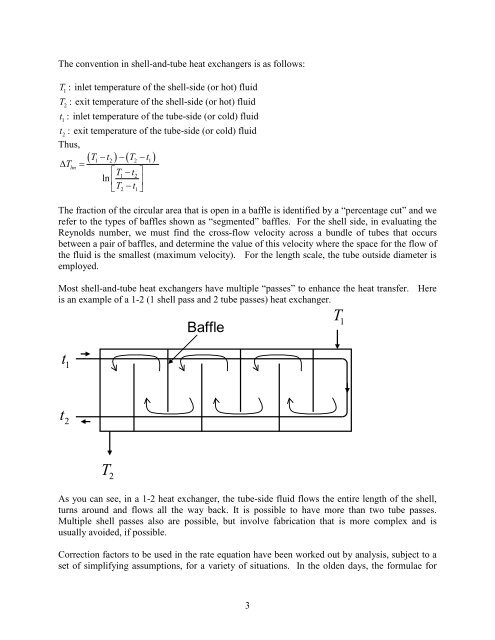Shell-and-Tube Heat Exchangers - Cheresources.com
Shell-and-Tube Heat Exchangers - Cheresources.com
Shell-and-Tube Heat Exchangers - Cheresources.com
You also want an ePaper? Increase the reach of your titles
YUMPU automatically turns print PDFs into web optimized ePapers that Google loves.
The convention in shell-<strong>and</strong>-tube heat exchangers is as follows:T : 1inlet temperature of the shell-side (or hot) fluidT exit temperature of the shell-side (or hot) fluid2 :t inlet temperature of the tube-side (or cold) fluid1 :t : 2exit temperature of the tube-side (or cold) fluidThus,( T1−t2) −( T2 −t1)∆ Tlm=⎡T1−t ⎤2ln ⎢T2 t⎥⎣ −1⎦The fraction of the circular area that is open in a baffle is identified by a “percentage cut” <strong>and</strong> werefer to the types of baffles shown as “segmented” baffles. For the shell side, in evaluating theReynolds number, we must find the cross-flow velocity across a bundle of tubes that occursbetween a pair of baffles, <strong>and</strong> determine the value of this velocity where the space for the flow ofthe fluid is the smallest (maximum velocity). For the length scale, the tube outside diameter isemployed.Most shell-<strong>and</strong>-tube heat exchangers have multiple “passes” to enhance the heat transfer. Hereis an example of a 1-2 (1 shell pass <strong>and</strong> 2 tube passes) heat exchanger.BaffleT 1t 1t 2T 2As you can see, in a 1-2 heat exchanger, the tube-side fluid flows the entire length of the shell,turns around <strong>and</strong> flows all the way back. It is possible to have more than two tube passes.Multiple shell passes also are possible, but involve fabrication that is more <strong>com</strong>plex <strong>and</strong> isusually avoided, if possible.Correction factors to be used in the rate equation have been worked out by analysis, subject to aset of simplifying assumptions, for a variety of situations. In the olden days, the formulae for3
















